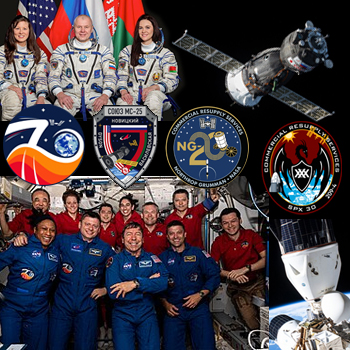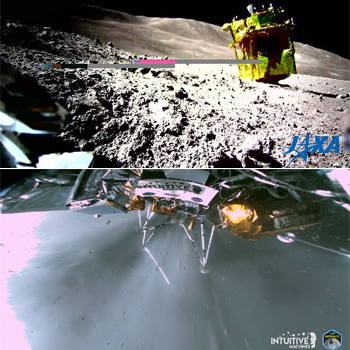ISS Undergoes Multi-Crew Changeovers and Cargo Arrival Heading into Expedition 71
The International Space Station, now more than 25 years in LEO and having 270+ Astronaut visitors, will see many rendezvous and departures this month of crewed and cargo spacecraft. Expedition 70 Commander Oleg Kononenko, Nikolai Chub and Loral O’Hara (arrived in Soyuz MS-24), and SpaceX Crew-8 members Matthew Dominick, Michael Barratt, Jeanette Epps and Alexander Grebenkin are set to welcome Oleg Novitsky, Tracy Caldwell-Dyson and the first Belarus woman in space Marina Vasilevskaya via Soyuz MS-25 on March 21. Exp 70 will remain a 10-member crew until April 2 when O’Hara, and “Visiting Expedition 21 Crew” Novitsky and Vasilevskaya are planned to return to Earth in Soyuz-24 and Expedition 71 will officially begin. Kononenko and Chub are assigned for a one-year long mission that will end on September 24 (marking 375 continuous days). Cargo craft docked are NG Cygnus-20 (S.S. Patricia “Patty” Hilliard Robertson), Progress 86 and 87 resupply ships. Set to launch March 23 aboard a SpaceX Falcon 9 rocket is the CRS-30 ship with nearly 3,000 kg of cargo including experiments C4 Photosynthesis in Space (APEX-09) which will grow 2 different grasses to test their ability to capture carbon dioxide in microgravity, the Nano Particle Haloing Suspension investigation to test how particles interact within an electrical field, and a Multi-resolution Scanner to be added to Astrobee to further test automated 3D sensing, mapping, and situational awareness systems. (Image Credits: NASA, Roscosmos, SpaceX, Northrop Grumman) |
MONDAY☆ Mar 18 — International Space Station, ~415-km LEO: Expedition 70 seven-member crew preparing for arrival of 3 others this week, planning change of command and start to Expedition 71 in early April. ☆ Mar 18 — Tiangong Space Station, ~390-km LEO: Shenzhou 17 three-member crew working with in-orbit electroencephalogram (EEG) test to study brain adaptions / functions; Shenzhou 18 now planned to launch to TSS on May 24. Highlights… o NewSpace: Indian Institute of Technology Madras partnering with Vellon Space to develop orbital biomanufacturing facility AsteriX Lab; Investigation ongoing into cause of Space One Kairos rocket self-destruct explosion 5 seconds after launch from Space Port Kii, Japan; NASA assisting Varda Space, Inversion Space, Rocket Lab with thermal insulation materials. ☆ Solar System: 9022-m equatorial Volcano on Mars “Noctis volcano” which may harbor glacial ice and be suitable for human landing identified using MRO; 18×28 cm tantalum plate inscribed with affixed silicon microchip containing 2.6M names and waveforms of ‘water’ in 103 languages to launch on Europa Clipper NET Oct; SPEARS2 polymer sensors capable of 400% stretch designed for off-Earth agriculture under development at UI Urbana-Champaign. ☆ Galaxy: 1.3-gigapixel image of Vela Supernova Remnant by Dark Energy Camera on Blanco 4-m telescope being analyzed; Hubble & JWST observation of 1,000 Cepheid variable stars in 5 galaxies confirms Hubble Constant universe expansion rate, conflicting with CMB measurements by 10%; Himalayan Chandra Telescope and Gaia observe open cluster NGC 2345 9,100-ly distant, determine 33.8-ly radius. o Global: China statement to UN COPUOS expresses support for space resource utilization without appropriation, within legal structure built around Outer Space Treaty; S Korea to increase space spending to US$1.14B by 2027 ahead of NET 2032 Moon landing; CASC considering establishment of federal agency to organize space data collected from 100+ launches expected from China in 2024. ● USA: SpaceX IFT-3 of Starship successfully reaches orbital speed, flight terminated over Indian Ocean; Biden-Harris Administration requesting NASA budget of $25.4B for FY2025 including $7.8B allocated for Artemis program; Zero-Boil-Off technology for cryogenic propellant efficiency during deep space missions being developed at Case Western under NASA grant. ● Hawai’i: TMT International Observatory director Kirshner optimistic for an ELT in Hawai’i as May decision on $1.6B funding nears; ILOA Hawai’i awaiting possible reactivation of Ka’ Imi NFoV and WFov imagers if Odysseus lunar lander awakens; UH Mānoa study produces glyceric acid under 10°K conditions at Keck Research Laboratory in Astrochemistry, mimicking abiogenesis processes which may be confirmed by ALMA. |
 |
● = Terrestrial and… o = International terrestrial events
☾ = Moon activity ★ = Space and… ☆ = International space / astro events in Hawaii Standard Time unless noted. Add 10 hours to obtain UT (‘Universal Time’). |
Weekly Planet Watch – Evening Planets: Mercury (W), Jupiter (W), Uranus (W); Morning Planets: Venus (ESE).
JAXA SLIM and Intuitive Machines Odysseus Await Lunar Daylight for Possible Reactivation
|
☆ Mar 18 — CNSA, Launch Long March 8 / Queqiao 2 & Tiandu 1/2, Wenchang Space Launch Center, Hainan Island, China (19° N): Queqiao 2 (Magpie Bridge 2) satellite to establish communications between Moon far side and Earth to launch with Tiandu 1 and Tiandu 2 to test and verify a wider Queqiao constellation for lunar communications and navigation. ● Mar 18 — Aerospace Company, El Segundo CA / Online: Space Partnerships and Competition in the Pacific. ● Mar 18-21 — Via Satellite, Airbus, Ball Aerospace, Blue Origin, Eutelsat, et al, Washington DC: Satellite 2024 Conference and Exhibition. ● Mar 18-22 — National Academy of Sciences, Washington DC: National Academy of Sciences Space Science Week 2024. ☾ Mar 18 — Moon: 4.9° S of Castor, 16:00; 1.51° S of Pollux, 22:00. Ongoing… ☆ Sep 6, 2023 – NET Mar — X-Ray Imaging and Spectroscopy Mission (XRISM), ~550-km LEO: XRISM undergoing 6 month check out testing phase before start of science operations to study galactic plasma. o NET Feb – NET Apr — CNSA, Online / Beijing, China: Primary selection of international payloads for Chang’E-8 mission. TUESDAY☾ NET Mar 19 — JAXA Smart Lander for Investigating Moon (SLIM) Lander, Lunar Surface, 13.31°S, 25.25°E: Lunar lander on surface of Moon may awaken for a second time around this date if conditions allow. ☾ NET Mar 19 — Intuitive Machines IM-1 Nova-C Lander, Lunar Surface, 80.13°S, 1.44°E: Lunar lander on surface of Moon being monitored from ground controllers, hoping to recharge / awaken around this date if conditions allow. ★ Mar 19 — Rocket Lab, Launch Electron / Live and Let Fly (NROL-123), Wallops Flight Facility VA: Launch of classified payload for National Reconnaissance Agency, 02:15 local time. ● Mar 19 — NASA, Washington DC: Media to Meet Space Station Astronauts at Headquarters; includes Frank Rubio, Stephen Bowen, Woody Hoburg, Sultan Alneyadi, 09:30 EDT. ● Mar 19 — Maryland Space Business Roundtable (MSBR), Greenbelt MD: MSBR luncheon with Makenzie Lystrup; Director of NASA Goddard Space Flight Center. |
● Mar 19-20 — Farnborough International, ADS Group, UKSpace, Farnborough, United Kingdom: Farnborough International Space Show.
☆ Mar 19 — March Equinox: The Sun rises exactly in east traveling through sky for 12 hours, sets exactly in west; every place on Earth experiences a ~12-hour day; 17:03.
☆ Mar 19 — Venus: At aphelion, 0.7282 AU from Sun, 12:00.
WEDNESDAY
● Mar 20 — CASA Moon, SSERVI, Institute of Meteoritics, University of New Mexico, LPI, Albuquerque NM and Online: CASA Moon Planetary Sample Science Seminar Series: Unraveling the micro-structure in apatite; by Marina Martinez, Universitat Autonoma de Barcelona, 11:00 MDT.
● Mar 20-22 — American Astronautical Society, College Park MD: AAS Goddard Space Science Symposium: Space 2024: Pathways to the Future.
☾ Mar 20 — Moon: 3.6° NNE of Beehive Cluster, 02:00.
THURSDAY
☆ Mar 21 — Roscosmos State Corporation, Launch Soyuz 2.1a / MS-25, Baikonur Cosmodrome, Kazakhstan: Roscosmos to launch Roscosmos Cosmonaut Oleg Novitsky, NASA Astronaut Tracy Caldwell Dyson and Belarus Cosmonaut Marina Vasilevskaya to ISS; 13:21 UTC.
★ Mar 21 — SpaceX, Launch Falcon 9 / Dragon CRS2 SpX-30, SLC-40, Cape Canaveral SFS FL: SpaceX to launch next Dragon cargo ship under Commercial Resupply Services program to ISS; 20:54 UTC.
● Mar 21 — Universities Space Research Association (USRA), George Washington University’s Space Policy Institute (SPI), Washington DC: Space Nuclear Technology: Research and Development for Evolving Space Missions.
o Mar 21-24 — International Academy of Astronautics (IAA), Turin, Italy: 1st Symposium on Moon Farside Protection.
☾ Mar 21 — Moon: 3.3° NNE of Regulus, 23:00.
☆ Mar 21 — Venus: 0.32° NNW of Saturn, 14:00.
FRIDAY
● Mar 22 — National Space Club and Foundation, Washington DC: 67th Robert H. Goddard Memorial Dinner.
● Mar 22 — Colorado School of Mines, Golden CO: Abstracts Due: 24th Meeting: Space Resources Roundtable (SRR 2024).
☆ Mar 22 — Apollo Asteroid 2023 RK44: Near-Earth Flyby (0.084 AU)
SATURDAY
☾ Mar 23 — Moon: At apogee; distance 406,288 km, 06:00.
☆ Mar 23 — Apollo Asteroid 2017 UQ7: Near-Earth Flyby (0.071 AU)
SUNDAY
☾ Mar 24 — Penumbral eclipse of the Moon: Visible from parts of Antarctica, Africa, western Europe, Atlantic Ocean, Americas, Pacific Ocean, Japan, and eastern Australia; begins at 18:53 HST.
☾ Mar 24 — Moon: Full Worm Moon, 21:00.
☆ Mar 24 — Apollo Asteroid 2019 CJ: Near-Earth Flyby (0.031 AU)

